First world war places of remembrance
Sous-titre
In Ile-de-France
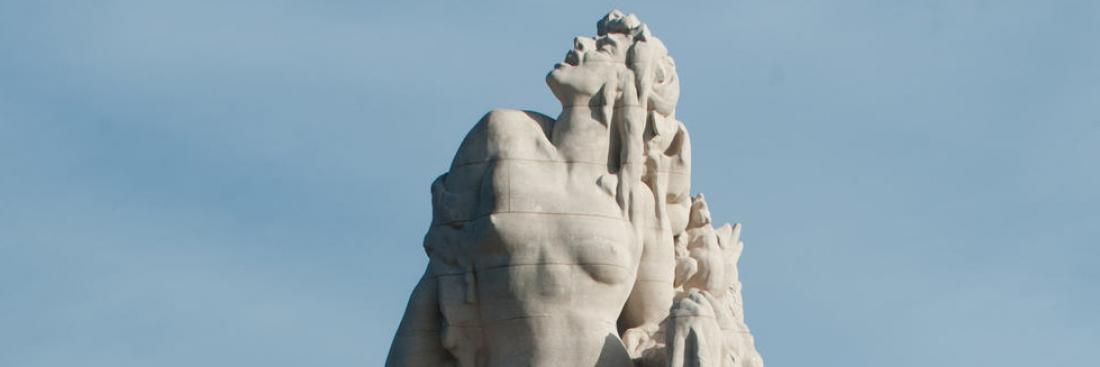
The Memorial heritage of Paris and its greater region is not particularly rich in monuments relating to the memory of the first world war since Paris was not directly concerned by the fighting. Paris did not experience the war so few monuments concern military operations.
However some monuments directly recall certain phases, for example the extreme advance of German troops that threatened Paris in September 1914:
- The American monument in Meaux for the first battle of the Marne
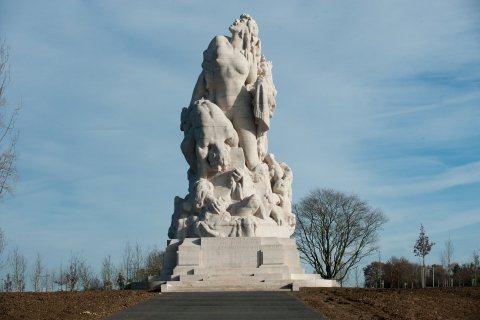
American monument in Meaux, detail. Source: Musée de la Grande Guerre
The monument is located route de Varreddes in Meaux (Seine-et-Marne), exactly where the first German Marne offensive was stopped in September 1914.
It is the work of American sculptor, Frederick Mac Monnies. It was funded in 1916 through subscriptions from more than 4 million US citizens. This memorial was intended as a symbolic gesture comparable to the donation by France of Bartholdi's Statue of Liberty. It was inaugurated on 11 September 1932 in the presence of President Albert Lebrun, the President of the Council Edouard Herriot and US General John Pershing.
- There are also a number of plaques recalling the bombing of Paris between March and August 1918 by converted naval guns. These long distance bombings (120 kilometres) which caused more than 800 casualties (injured and dead) were improperly attributed to the giant howitzer ”Big Bertha” used on the front by the Germans to destroy forts and opposing trenches.
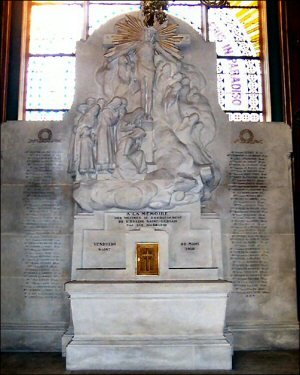
Commemorative plaque at Saint-Gervais Church. Source: http://www.memorial-genweb.org
A very symbolic plaque recalls the disaster which occurred on 29 March 1918 at 3.00 pm when a shell fell on Saint-Gervais Church, located behind the Town Hall and filled with people attending a concert of sacred music: 91 people were killed.
Monuments dedicated to Great War personalities
Conversely, many monuments are dedicated to the protagonists and personalities who experienced or were involved in the great war.
Military personalities are well represented among these:
Marshal Joffre
- Plaque. 6 rue Michel-Ange - Paris XVI
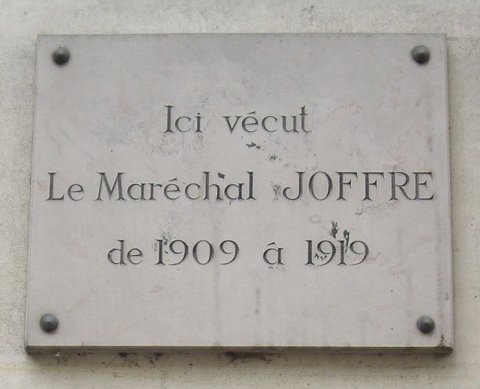
Plaque at No. 6 rue Michel-Ange, Paris 16e, where Marshal Joffre lived (1852-1931) from 1909 to 1919. Source: Wikimedia Commons
-
Plaque. 17 avenue de Lamballe - Paris XVI: ”Marshal Joffre 1852-1931, Victor of the Marne, lived here at the end of his life”
Marshal Foch
-
Plaque. Bombon - Seine-et-Marne
During the offensive in the Summer of 1918, the general headquarters of the Allied armies, led by Foch, were based in the castle. A sealed plaque in the Church recalls this episode.
-
Plaque. 52 avenue de Saxe - Paris VII
In May 1917, the family moved in to this house and lived here until 1920. This is where Foch went to on the night of the Victory as recalled by a plaque placed here in 1930.
- Monument Place du Trocadero - Paris XVI
Equestrian statue of the Marshal
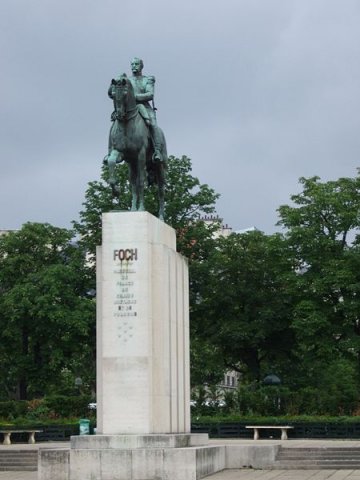
Statue of Marshal Foch. Author: Franck Segretain. Source: MINDEF/SGA/DMPA
-
Monument Hôtel National des Invalides -Paris VIII
Marshal Foch lays at rest under the Invalides dome in Paris
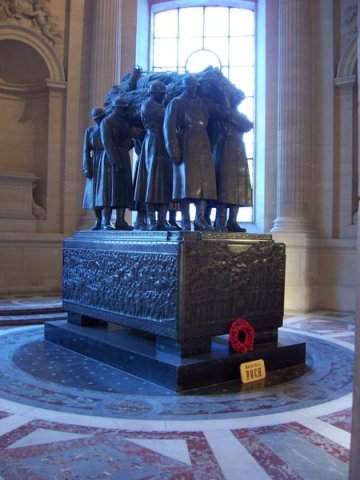
The tomb of Ferdinand Foch at Les Invalides. Author: Peter Schmidl Source: GNU Free Documentation License
General Mangin
-
Monument Place de l'Eglise Saint-François-Xavier - Paris VIII
This monument to General Mangin replaces the one blown up by the Nazis in June 1940.
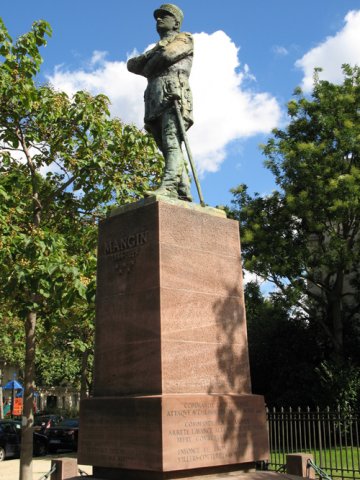
Statue of General Mangin. Author: Franck Segretain. Source: MINDEF/SGA/DMPA
Georges-Marie GUYNEMER
-
Stone. Cité de l'Air- boulevard Victor - Paris XV
The Cité de l'Air is named after Captain Guynemer, 2 July 1984.

The Vieux Charles (Old Charlie) is Guynemer's aircraft preserved at the Air and Space Museum. Author: JP Le Padellec. Source: MINDEF/SGA/DMPA
- Dedication. Pantheon - Paris V
The name of Guynemer entered the Pantheon in accordance with the proposal from the lower house on 19 October 1917.
Some monuments are to the ”politicians'' who ruled the country during the war.
Georges CLEMENCEAU
-
Statue. Avenue des Champs Elysées - Paris
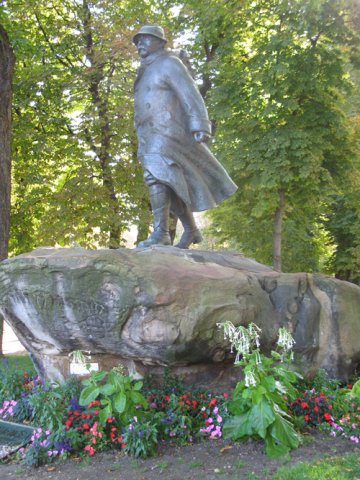
-
Stone bust. Luxembourg Palace - Paris
Stone bust - a work by the sculptor Sicard. On desk No. 14, a medallion engraved with the profile of the President marks the location he occupied in the debating room.
-
Plaque. 8 rue Franklin - Paris
Apartment and office of Clemenceau
-
Monument Paris VIII
The Tiger monument, Clemenceau, work by Coigniet.
Raymond POINCARE
-
Bust. Luxembourg Palace - Paris
The personality of former Senator of the Meuse is recalled by a bust placed near the entrance to the palace.

Raymond Poincaré in 1914. A work by Harris & Ewing. Source: Wikipedia commons. Public domain.
Famous intellectuals and civilians who died during the war are also well represented.
Charles PÉGUY (poet)
-
Monument Chauconin-Neufmontiers - (Seine-et-Marne)
Monument in the national cemetery where Charles Peguy is buried
Guillaume APOLLINAIRE (Poet)
-
Plaque. 202 Boulevard Saint-Germain - Paris VII
In this house lived and died the poet Guillaume Apollinaire...
Similarly, many monuments recall those from the great Parisian institutions who died.
We can cite the war memorial for the Inspectorate of Finance (1920), that of the Ecole Normale Supérieure (1923), both being works by the great sculptor Landowski or that of the Legion of Honour (1925) that we owe to Henri Bouchard.
France was keenly aware at a very early stage of the debt it owed to its allies and several monuments are spread around the Ile-de-France region. The following are based on nationality:
-
Belgians:
Paris (20th), Père Lachaise Cemetery: memorial

War memorial to Belgian soldiers who died in France between 1914 and 1919. Author: JP Le Padellec. Source: MINDEF/SGA/DMPA
Paris (8), Cours de la Reine: monument to King Albert the 1st
Paris (8), Place de la Reine Astrid: monument to French-Belgian entente
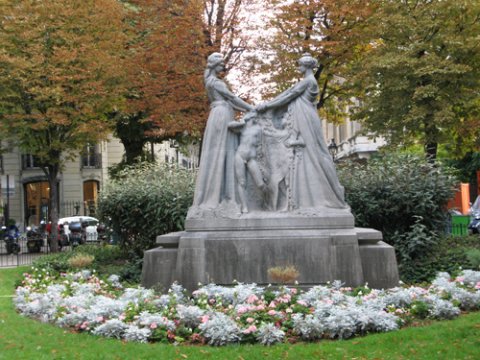
Monument to French-Belgian entente. Author: Franck Segretain. Source: MINDEF/SGA/DMPA
- British. : La Ferté sous Jouarre (Seine et Marne): Memorial to those Missing in action in the Mons, Marne and L'Aisne battles as well as a monument to the ”Royal Engineers” of the 4th Division (fought in 1914)
- Italians: Ivry/Seine (Val de Marne), in the municipal cemetery, Italian section with monument; Paris (20)
Pere Lachaise Cemetery: monument to the Italian volunteers in the Foreign Legion:

Monuments to the Argonne ”Garibaldians” and Italian volunteers who died for France. Author: JP Le Padellec. Source: MINDEF/SGA/DMPA
-
Polish: Paris (7th), Hôtel des Invalides: commemorative plaque
-
Portuguese: Paris (16th): commemorative plaque Avenue des Portugais
-
Romanians: Paris (8th), Avenue de l'Opera, plaque commemorating the Committee of the Romanian unit (1917-1919)
-
Czechoslovaks: Paris (20th): monument to the dead in Père Lachaise cemetery. Plaque rue Bonaparte (provisional Government 1916)

War Memorial to Czechoslovak soldiers who died in France between 1914 and 1918. Author: JP Le Padellec. Source: MINDEF/SGA/DMPA
Monuments to French colonial troops, the example of the Tropical Garden
In 1899, a test garden was created in the Bois de Vincennes to study and develop tropical plants for production.
From May to October 1907, the site was used to host a large colonial exhibition which included reconstituted indigenous villages (Congo, Madagascar, etc.).
The buildings were built or transferred there. For example, the ”Reunion Pavilion” existed since 1901, that for Tunisia was built in 1907; the ”Chinese Gate” came from the colonial exhibition in 1906 organized at the Grand Palais in Paris.
During the 1914-1918 war, the buildings built for the 1907 exhibition, including the vast ”Indo-Chinese Pavilion” was used as a temporary military hospital (the dead being buried in the Nogent/Marne cemetery).
In 1917, an association founded by Far East veterans, eager to pay tribute to the Annamite soldiers who ”died for France”, obtained ownership of the Thu Dau Mot communal temple from the state and transformed it into a Buddhist temple in remembrance of the dead.
In 1919, Khai Dinh, the Emperor of Annam, decided to dedicate this site to the spirits of the Annamites. Meanwhile, two monuments were erected nearby: one for
Christian Indochinese, the other for Laotians and Cambodians.

War memorial for Cambodians and Laotians who died for France. Author: Gilles Roland. Source: MINDEF/SGA/DMPA
In 1927, Emperor Khai Dinh and his son - the future Bao Dai - paid a visit to the Temple (destroyed in 1984, it was replaced by a symbolic pagoda in 1992).
Since the site became specifically devoted to the memory of the deceased since the dedication of the pagoda, other monuments were built in the twenties: a monument to the Blacks who ”died for France”

Monument to the black soldiers who died for France. Author: Gilles Roland. Source: MINDEF/SGA/DMPA
Another, more general monument to the ”Colonials” (in a very broad sense: Tonkinese, Tahitians, Congolese, Indochinese, Martinicans, etc.)

Monument in memory of soldiers from Madagascar. Author: Gilles Roland. Source: MINDEF/SGA/DMPA
a third one to Malagasy soldiers.

Monument to Indochinese Christians who died for France. Author: Gilles Roland. Source: MINDEF/SGA/DMPA
Finally, Paris is of course the capital city and as such is home to some of the monuments that are ”national symbols” of this conflict.
While the Monument to ”the glory of the French army 1914-1918” is in the 16th arrondissement, it is the Arc de Triomphe that is home to the unknown soldier since the morning of January 28, 1921, a symbol if ever there was one of the toll that the war took on the French population.

The flame on the tomb of the Unknown Soldier. Author: Jacques Robert. Source: MINDEF/SGA/DMPA
The remains of some of the great French Army leaders during the conflict are laid to rest in Les Invalides. Marshal Foch is thus buried in the Saint-Louis church, where a ceremony is organised every year by the Military Governor of Paris in the presence of his family, Great Britain's military attaché and Poland's Military Attaché in France.
A little-known aspect is the architectural and cultural legacy of the Great War.
One of the consequences of the First World War was the building of the Great Mosque in Paris (first mosque ever built in France), with the decision in principle being taken in the wake of the Battle of Verdun in which numerous Muslims were killed. The cornerstone was laid in 1922 and it was inaugurated on 15 July 1926 by the President of the Republic, Gaston Doumergue.

The Great Mosque of Paris. Author LPLT. Source: GNU Free Documentation License
In churches, numerous plaques and/or chapels also recall the sacrifice of many Parisians.
The ”wave” of war memorial construction also dates from the immediate postwar period. Most monuments were built between 1919 and 1923. The state encouraged this movement by providing grants for municipalities wishing to honour their residents who ”died for France” in the law of 25 October 1919.
The Paris and Ile-de-France museums.
The memory of this conflict is present in many museum rooms and theme museums, including:
- La maison Clemenceau, in Moret-sur-Loing (Seine-et-Marne);
- Le Musée Clemenceau, in Paris

Clemenceau's working office. Source: Civique, n°145, April 2005
- The three ”defence” museums (Army Museum, Navy Museum, Air and Space Museum);

Hôtel National des Invalides. Author: Jacques Robert. Source: MINDEF/SGA/DMPA
- The carrier pigeon museum in Suresnes;
- Tradition room of the Republican Guard....
National cemeteries and military sections
A number of national cemeteries also mark the territory of the Ile-de-France region, among them:
-Chauconin-Neufmontiers (in Seine-et-Marne) called the ”Great Tomb of Villeroy”, actually an ossuary where Peguy's remains lie after his death on 5 September 1914 at the Battle of L'Ourcq;

National cemetery erected in 1932 near the spot where Charles Peguy was killed during fighting in September 1914. Author: Gilles Roland. Source: MINDEF/SGA/DMPA
- Etrepilly and Chambery (where the war memorial to the ”Army of Paris” is located) are two other national cemeteries for the same battle.
We can also mention the Parisian military sections where the soldiers who died in the city's hospitals during the conflict are buried.
France's former Allies and opponents also have cemeteries dedicated to them, for example:
- The American Cemetery in Suresnes

The American Cemetery in Suresnes. Source: American Battle Monuments Commission
- The section with 748 Serbian soldiers in Thiais (Val-de-Marne)
- The German Versailles section which has 37 tombs from 14-18.
Among the tombs in Père Lachaise cemetery
Numerous individual monuments dot the Parisian cemeteries, the most famous among them being in Père Lachaise cemetery. They form numerous individual remembrance sites for the tragedy that was the First World War for millions of anonymous individuals. Among these is the tomb of Apollinaire.

Guillaume Apollinaire's tomb in Père Lachaise Cemetery. Author: JP Le Padellec. Source: MINDEF/SGA/DMPA
This brief inventory does not claim to be exhaustive but tries to present the various types of First World War monuments and memorials Parisians or visitors can expect to find in the Ile-de-France region.

